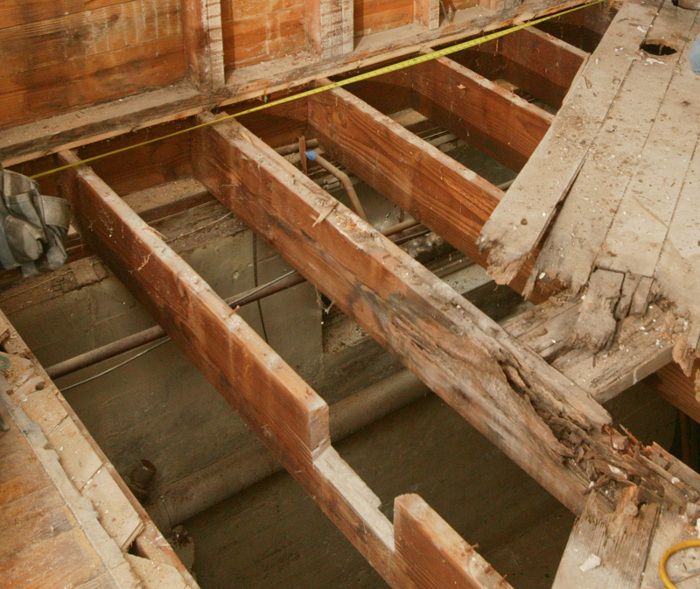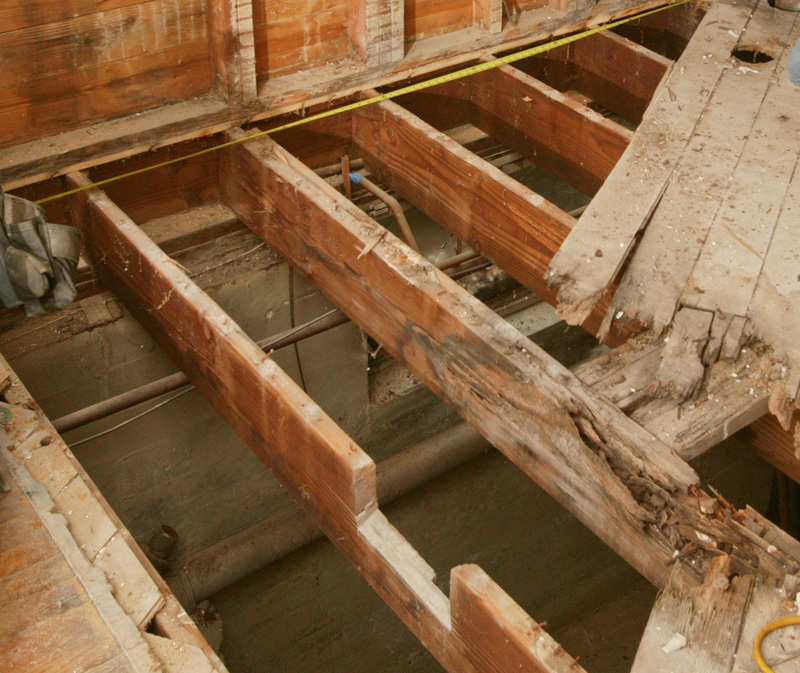How to Repair a Butchered Floor Joist

Do all plumbers hack away offending pieces of framing as they run drain lines, set toilets, and otherwise go about their rough-ins? Of course not. Yet this reputation, or maybe we should call it an urban legend, has a way of lingering. And Tackitybits could tell you why: He’s seeing first-hand what happens when the only thing standing between a plumber and a successful toilet installation is a floor joist.
“Eleven years later I find the toilet, flooring and subfloor all failing because of the sag in the floor, created by sawing through an I-beam joist that runs the length of the house,” Tackitybits says in a post at Fine Homebuilding’s Breaktime forum. “The joist was cut to make room for the PVC waste pipe for the toilet.
“Only a small section in the Master Bath is affected but it looks like I will have to pull the vanity, cut out old sub flooring and figure out how to support that section of the floor where the toilet will rest, once all the repairs are done,” Tackitybits continues. “It’s possible I might be able to sister up about a 14-foot length of joist to the I-beam that’s been sawed through. Is that the best way to go? What about the sag?”
It may look like an open-and-shut case of plumber malfeasance, but some of the replies to the original post disagree. Maybe the plumber tried to get the framer to fix the problem but was ignored. Why didn’t the framer anticipate the plumber’s dilemma and move the joist? Where was the general contractor while all of this was going on?
And, as important, what the heck is Tackitybits supposed to do about it now?
That’s the topic for this month’s Breaktime Spotlight.
Homeowner has an ‘easy’ lawsuit
In a situation like this, it’s easy to heap scorn on the plumber.
“It pisses me off to no end when plumbers do that,” writes BossHog.
MLB_Construction is not far behind: “Do you know the plumber that did this? Is he still in business? If you know his name and he’s still around, I would contact him first. He has codes he has to abide by and he knows what he can and cannot drill through. You can plumb through I-joists but not like that.
“You have an easy win with a lawsuit,” MLB continues.
And finally this tongue-in-cheek addendum from DanH: “Ah, but part of the ‘code’ is that a plumber has to saw through some structural member on every job. If he doesn’t they’ll drum him out of the union. Same as the rule that an electrician must drill through at least one drain pipe.”
Ouch.
“…There is NO excuse for the plumbers’ action,” adds Renosteinke. “It violates the first rule tradesmen are taught: Don’t mess with the structure. When the plumber discovered the problem, THEN was the time to stop work and say ‘I can’t do my job until the framing is changed or the toilet relocated.’
“I can’t understand how pumbers get away with this all the time – somehow inspectors have no problems nailing electricians for similar issues. Let a few plumbers get charge-backs, and you can be sure the problem will disappear. Let a few jobs grind to a halt, while the ‘fix’ is approved and the framer gets a charge-back, and the problem will disappear. Let a few architects and engineers eat the change orders, and suddenly the framing plans will improve.”
Plenty of blame to share
Although the plumber apparently did the cutting, the problem may have originated elsewhere, Rdesigns suggests. Everyone from the building inspector to the general contractor could share some of the blame.
“The problem started with the framer–he KNOWS that toilets rough in at 12 in. from the back wall, and his floor plan showed where it was to be located side-to-side,” Rdesigns writes. “The plumber probably located the toilet right where the plan showed. Did he tell the framer that he had to chop the joist? Maybe. But, even if he didn’t, the framing inspection is supposed to be done after the other trades (plumbing, electrical, HVAC) have finished. The framing inspector should have caught this, but he might not have bothered to crawl under there to check.
“The general contractor would share blame as well since he hires the subs.”
Quit picking on the framer, MLB argues. “You can’t blame it only on the framer,” MLB writes. “They go by the framing plans, which do onot show toilet locations unless the architect puts it in the framing plan. “If this was done via a bathroom remodel then the responsibility lies on the contractor who did the job or the plumber if the homeowner acted as the contractor. Plumbers know better. They should have stopped the job and told someone what was going on.”
BossHog would still give the screw-up award to the plumber. “All he had to do was stop and let the GC or framer know there was a problem, rather than cutting an I-joist in half. Anybody with half a brain knows that’s wrong.”
But DanH is still pleading for understanding. “We don’t know a lot of things,” he writes. “The plumber may have been screaming for three days that there was a problem, while the contractor just scratched his arse and did nothing about it. In which case I’d not blame the plumber for butchering the joist.”
How to fix the problem now
Whether it was the plumber, framer, inspector or someone else who’s ultimately to blame, Tackitybits still faces the question of how to repair the damage. The I-joist is incapable of bearing its full load, as evidenced by a sagging floor.
Harryvermehren has this suggestion:
“Possible fix. Install 8-ft. pieces 3/4-in. plywood web stiffeners on both sides of the I-joist on either side of the hacked one. Remove a section of the hacked I-Joist, add new I-joist perpendicular on both sides of the plumbing pipe using hangers. The new I-joists should have plywood web stiffeners also. Most I-joist pocket framing guides show an example of how this is done.”
If the bathroom is over a crawlspace (which it is), IdahoDon writes, the solution seems like a “no-brainer.” Head off the damaged section and add a few load-bearing posts on adjustable post bases and precast concrete bases. “That will pass code anywhere,” Idaho says, adding that if Tackitybits isn’t sure how to carry out the repair I-joist manufacturers can offer plenty of advice.
DanH suggests adding “squash blocks” to the ends of the I-joist, then some cross-bracing so the ends of the I-joists won’t twist. Place concrete pads under the cut ends of the joist and install jack posts. “There are several variations on how this might be done,” he says, “but that’s the gist of it.”
In a members-only article from issue# 232, plumber Mike Lombardi demonstrates how to fix a failing bathroom floor.
In the Q&A department of this same issue, the Fine Homebuilding editors asked code official Glenn Mathewson how to safely lower floor framing to make room for a barrier-free shower.
Fine Homebuilding Recommended Products
Fine Homebuilding receives a commission for items purchased through links on this site, including Amazon Associates and other affiliate advertising programs.

8067 All-Weather Flashing Tape

Handy Heat Gun

Reliable Crimp Connectors

Our editors were faced with a similar problem during this recent bathroom remodel at the Fine Homebuilding Project House.























View Comments
Recently when replacing a cracked 36X60 fiberglass shower I discovered the plumber had cut 4 inches out the top chord and field of the TJI floor joist. This was the likely cause of the crack in this shower pan in a house only 5 years old when we bought it. The joist was encased in spray foam so it was invisable to the home inspection we had done. Turns out the TJI manufacture has a tech department that will give the owner a fix for plumbers butchery. All I needed to do was fill out a form with info such as TJI size, span, etc. and they came back with several options for the fix. I was able to fix by installing another TJI joist adjacent to the butchered one. Weyerhauser was company I dealt with and being able to painlessly get a free engineered fix was great...
I put the blame squarely on the plumbers. Never, ever cut a joist. Next on the list, the worthless building inspectors who allow their favorite contractors to move at warp speed to finish a job without enough oversight.
I may be missing something here but it appears to me that the homeowner did more damage than the plumber by ignoring the water problem for a number of years. Yes the plumber should have supported his notch in the floor joist but the water damage is far more damaging.
Not so sure I'd put all the blame on the plumber, some but not all. According to the law of the California Contractors Board the person primarily responsible for the entire construction project is the general contractor. Even if the home owner themselves are acting as the contractor it is there responsibility to make sure the rest of the trades have done their jobs correctly and to code. The plumber may have been an idiot but the person in charge of the jobs was a bigger idiot for approving the plumbers work.
One of the good parts of building in California is every construction job needs a permit before starting. Every person acting as a sub-contractor needs to be tested before being licensed. Every job is inspected multiple times in the building process, and every inspector has to be tested and licensed. Not saying this could not happen here in CA but the chances are not as good as in states where there are no or little building requirements.
I'd put the blame on the builder since that person was in charge of making sure the project was built correctly.
I am not knowledgeable about specific codes and I'm not a plumber, just a handy homeowner. I did notice in the photo (at least) that the badly deteriorated joist appears to be sistered or doubled and I might theorize that it was done originally to help carry the load from the butchered joist. Like I said, I don't know what "code" says about this, but could posit that the real problem with the floor could be the water deterioration that the owner allowed to take place over a long period of time.
I wish I had photos - had the same problem of cracked bottom on a one-piece tub/shower enclosure. While replacing it we determined that the rough plumber had cut through all but about 1 inch of the joist directly under the tub. No way to repair it without significant demolition... we replaced the tub with a porcelain steel (not heavier cast iron) unit that bore its load on the adjacent two joists.
About three years later, while working on a kitchen remodel and addition, we discovered that said rough plumber had also cut through all but about 2" of the next joist over. Both cuts were several (8+") wide, as he ran the pipe at about 45 deg to the joists. It's a wonder that the tub full of water didn't end up in the kitchen below. This time, with the back wall off the house to install a steel beam, we were able to slide a couple of new joists in, glued and bolted together, and re-route the pipe down the space between joists.
I wonder why rough plumbing and electrical isn't better planned for during design. Why are service trades permitted to make any structural mods to framing?
I wish I had photos - had the same problem of cracked bottom on a one-piece tub/shower enclosure. While replacing it we determined that the rough plumber had cut through all but about 1 inch of the joist directly under the tub. No way to repair it without significant demolition... we replaced the tub with a porcelain steel (not heavier cast iron) unit that bore its load on the adjacent two joists.
About three years later, while working on a kitchen remodel and addition, we discovered that said rough plumber had also cut through all but about 2" of the next joist over. Both cuts were several (8+") wide, as he ran the pipe at about 45 deg to the joists. It's a wonder that the tub full of water didn't end up in the kitchen below. This time, with the back wall off the house to install a steel beam, we were able to slide a couple of new joists in, glued and bolted together, and re-route the pipe down the space between joists.
I wonder why rough plumbing and electrical isn't better planned for during design. Why are service trades permitted to make any structural mods to framing?
This is my best come back for the curse of the long dead plumber....
http://i634.photobucket.com/albums/uu61/neoliticman/RacineAwaitingPlumber001.jpg
http://i634.photobucket.com/albums/uu61/neoliticman/001.jpg
Sometimes I can't believe the problem waited a hundred years for me to get there :)
I wouldn't be so quick to blame the homeowner for the water damage, either...in the front bathroom with the tacky linoleum, well worn fixtures,and glue-on tile facade from the horrible 1970's era remodel at my house, we found the subfloor in tip-top bone-dry condition. In the back bathroom with the original early '60s mortar bed shower and fairly pristine looking tile floor...another story. Never did find what leaked (although the wax seal on the toilet looked pre-Columbian) but I was surprised the tile hadn't cracked...no visible signs up top.
BTW, not always the PLUMBERS that cut supporting frame members. While removing the obsolete sheetrock furnace chase from behind the old shower stall, we realized that the furnace installer had notched a good 3 inches out of a load bearing beam.
My 1826 house had multiple cut joists. One fix I did was to sister on new joists; I jacked up/straightened out the floor before gluing, nailing, and carriage bolting the new joist to the cut joist. I've also sistered on steel flat plate when I wasn't able to nail on a long enough replacement joist (for example, existing plumbing or electrical wires prevent you from getting a full length joist installed).
Obviously installing jack columns in the crawl space would be a somewhat easy fix...I've done that in some cases as well, but getting concrete (for footings) into a crawl space is tough on the back. The joys of old houses!
All plumbers run into this or similar framing problems at times. I can't ever recall a situation where a word to the framer or GC didn't fix the problem immediately. If there wasn't anybody around to change things I would head up the framing myself; cutting a joist as in the picture is inexcusable.
On one jobsite I saw that a plumber actually completely cut through a load bearing beam to run a bunch of pex totally comprising its load bearing ability. I had the plumber fired. There was an existing chase he could of have used to fish his pex. Most plumbers are considerate, smart, and know the codes regarding cutting into load bearing framing. But every now and then you encounter someone who completely disregards code and common sense. But needless to say that happens in all the trades and isn't isolated to plumbers.
Thanks for this post.you might be interested in checking out fine luxury homes by Brejnik Fine Homes (www.brejnik.ca). They build fine luxury houses. Brejnik team consists of qualified and trusted: Architects, Interior Designers, Appraisers / Lenders, Trades & Suppliers, Geo-technical engineers, Structural Engineers, Arborists, Landscape Architects, Pool & Water Feature.
This really rotten problem was clearly ignored for years - we enjoy having a go at the trade that makes a mess of our own., becoming indignant is its own social platform...Its difficult to get trades-people to take these types of jobs seriously once they discover what they are into and Fixustemporitis sets in...the belief that I'm just going to hack it in and move on becomes the norm., unfortunately that is real and happens a thousand times a day.